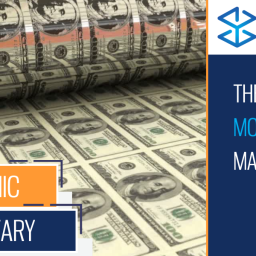
FIRST QUARTER 2023 RECAP
In a nice reversal from last year’s market performance when the S&P 500 Price index was down more than 19% and the bond market had its worst year on record, the S&P 500 posted a 7% gain in the first quarter of 2023 while the Bloomberg U.S. Aggregate Bond Index gained 2.5%. This positive sentiment change largely has to do with several factors:
- U.S. monetary policy, as orchestrated by the Federal Reserve, should pose fewer headwind risks going forward to the markets now that the Fed’s tightening (increasing interest rates) cycle appears to be in the late stage.
- Recent economic data and declining year over year inflation numbers both underpin improving investor confidence that the Federal Reserve’s price stability policy measures are showing to function as intended.
- Prior corrections in housing, manufacturing, and both stock and bond markets over the past year suggest a more balanced risk environment going forward.
- Due to the late March banking turmoil and anticipating its fallout will lead to much tighter lending standards, forecasts for the timing of eventual Federal Reserve interest rate cuts have accelerated with the increasing likelihood of a recession.
INFLATION RATE DECLINE
As shown in the chart below, year over year inflation, as measured by the Consumer Price Index (CPI), peaked last June and has been steadily coming down while increases in the federal funds rate have consistently pushed the cost of money higher. Relating back to StrongBox Wealth’s 4Q 2022 commentary, The Cost of Money Matters, “The Federal Reserve is hiking rates further and faster than it has in over forty years as an aggressive effort to curb high inflation (rising prices). Higher rates create a detrimental impact on home prices, stock and bond prices, and business profits while, at the same time, increasing the cost of borrowing money.” It is important to note that the gap between the CPI and fed funds rates has significantly narrowed. As of this writing, the current fed funds rate is 4.75% and the March 2023 CPI report showed additional inflation declines by posting at 5.0% year-over-year. The Fed defines “restrictive” policy as having fed funds rate over its long term neutral policy rate of 2.5%. Thus, the current 4.75% rate undoubtedly qualifies as overly restrictive and forecasts still indicate the probability for at least one more rate increase before the Fed moves to a “data dependent” wait and see approach. With the 5% CPI rate still above the Fed’s 4.75% rate, many believe the Fed’s ultimate policy goal going forward is to ensure CPI first stabilizes at a rate well below the fed funds rate and well prior to them cutting rates. While StrongBox Wealth agrees with that base case, we also maintain that higher rates will do only so much to quell inflation, as other money supply forces are in play to keep CPI elevated above the Fed’s long-term target.
Many market forecasters believe the Fed will “pivot” and soon begin loosening their policy by reducing interest rates based on the likelihood of an approaching recession. By contrast, we believe the Fed’s repeated narrative that they will be data dependent toward crafting forward policy and expect interest rates to remain stubbornly higher until the Fed sees inflation much closer to their long term 2.5% neutral policy rate. Given this extraordinary inflation environment, make no mistake in thinking that the Fed would rather ease up prematurely on rates than primarily be at fault for causing a recession.
money supply – the pig in the python
As has been our consistent belief since the federal government’s multiple COVID-19 response programs increased the U.S. money supply by 40% – over 6 trillion dollars – to cause an artificial spike in savings while pulling forward consumer expenditures, there has been ample reason for this inevitable wave of inflation to set in. Though the rate of price increases has steadily come down from last summer’s peak, the residual money supply effect still leaves a “pig in the python” that, in our view, will only be fully absorbed into the economy over a material amount of time. Just like the bunching of age population spike anomaly caused by the post WWII baby boomer generation led to a distinct bulge effect in our economy for many decades, the post-COVID money supply spike created the material effect of systemic inflation for the foreseeable future. A favorite economist of ours gave this simple example to illustrate the money supply induced inflation point: all else equal, if the economy is comprised of $100 dollars and 10 apples, then easy math figures each apple to cost $10. If you then increase the money supply circulating in the economy to $140, then each of those same 10 apples now costs $14. This wave of inflation is exactly what was created over the last few years, primarily due to the 6 trillion dollar money supply surge. Oddly, money supply growth is seldom attributed as a root cause for our current state of affairs. Instead, most financial pundits consistently talk about the Federal Reserve policy as being “behind the curve” and late in raising rates. Efficient port operations and normalized logistics have long been restored and inventories have leveled, despite supply-chain disruptions also being cited as an ongoing primary driver of high inflation. We conclude that while this excess money supply (pig) is slowly digested into the economy (python), it is prudent to anticipate and plan around elevated prices remaining into the foreseeable future. Further, there is little chance for costs of overall goods and services to fall back to pre-COVID levels.
banking turmoil
The recent failure of Silicon Valley Bank was the second biggest bank failure in U.S. history and the largest since 2008. Quick to follow, Signature Bank then closed to become the third-largest bank failure in the U.S. This turmoil began as a lapse in sound management. SVB was flooded with deposits during 2019-2021 and invested that capital in longer-term U.S. Treasury securities. With the spike in yields last year due to inflation and subsequent aggressive Fed policy, SVB and other banks developed deep losses in their longer-dated Treasury holdings. This caused uncertainty to spread and has since evolved into clear anxiety around the banking system. Bank lending saw the largest 2-week decline ever after the collapse of SVB while simultaneously registering the largest drop in deposits ever. The U.S. Treasury, Federal Reserve, and FDIC announced the government would backstop deposits (both insured & uninsured) for SVB and Signature Bank. The Fed also announced a new facility, the Bank Term Funding Program (BTFP), which offers loans of up to one year by pledging U.S. Treasuries as collateral. Actions by the federal government and Federal Reserve were extremely important to restoring stability in the financial system and markets. The market is still trying to figure out the scale of the problem in the banking system. There is a growing consensus that the fallout will translate into tighter lending standards, primarily to be endured by small businesses, and enable deflationary pressures through a pickup in unemployment. It is by this rationale that a growing consensus believes the Fed will likely significantly slow, if not altogether refrain, from continuing to increase overnight interest rates.
bank deposit rates
There are nearly $3 trillion in bank reserves on which the Fed pays interest direct to member banks. For perspective, the total commercial banking system credit is $17 trillion. With short-term interest rates paying nearly 5% to those banks, about $150 billion per year is earned on those reserves. Yet, national bank deposit rates credited to its customers are very different. As sourced by the FDIC on March 23rd, the yield on bank savings deposits nationwide is 0.37% while the yield on average bank money market is 0.54%. For many years, the low-interest rate environment made it challenging for savers to earn a decent return on their savings. However, now that cash alternative rates have risen the fastest in over forty years, coupled with anxiety created by recent SVB and Signature bank failures that shined a spotlight on the fact that 43% of domestic bank deposits are beyond FDIC insurance limits (chart below), depositors are paying attention and seeking alternatives.
Because widely embraced banking technology facilitates money movement with a few keystrokes, there is a seismic shift taking place in the mobility of liquid balances between financial institutions. As the chart below illustrates, since the Fed began increasing interest rates last year higher cash rates on alternatives to checking and savings accounts, such as purchased money market funds and short term U.S. Treasury bills, have lured nearly 900 billion dollars away from traditional bank deposits.
TO CONTINUE READING WHICH INCLUDES DISCUSSION ON THE DEBT CEILING DEBATE, AND A LOOK AHEAD AT THE ECONOMY, STOCK MARKET, AND GEOPOLITICS INCLUDING SECTOR PERFORMANCE FOLLOWING THE END OF A RATE HIKE CYCLE, DOWNLOAD THE FULL ARTICLE BELOW.
Download Full Article
StrongBox Wealth LLC is registered as an investment adviser with the Securities and Exchange Commission (SEC). StrongBox Wealth LLC only transacts business in states where it is properly registered, or is excluded or exempted from registration requirements. SEC registration does not constitute an endorsement of the firm by the Commission nor does it indicate that the adviser has attained a particular level of skill or ability.






